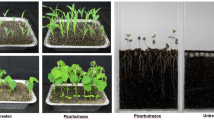Abstract
Pyrenophora tritici-repentis (anamorph: Drechslera tritici-repentis) causes yellow spot of wheat. The disease can be responsible for yield losses of 30–50% and, when severe, requires management with fungicide. Forty-five single conidium isolates collected from the northern wheatbelt of Western Australia were tested for sensitivity to three triazole fungicides in culture. At 0.2 mg/mL epoxiconazole and 0.4 mg/mL propiconazole and tebuconazole, the mean relative diameter of cultures was close to 50%, indicating that epoxiconazole had about twice the in vitro activity of propiconazole or tebuconazole. Isolates exhibited a significant fungicide rate interaction such that some isolates differed in response to propiconazole compared with epoxiconazole or tebuconazole. Sensitivity among 32 isolates collected from commercial wheat crops over the period 2001–03 was not significantly different from sensitivity among 13 isolates collected in 1986–87 when fungicide use was minimal. The observed EC50 values (concentration of fungicide required to cause 50% inhibition of growth of isolates) provide a basis to monitor potential changes in sensitivity to azole fungicides.
Similar content being viewed by others
References
Anon. (2005) ‘Wheat disease management — 2005 update.’ (Home Grown Cereals Authority: London)
Bhathal JS, Loughman R, Speijers J (2003) Yield reduction in wheat in relation to leaf disease from yellow (tan) spot and septorianodorumblotch. European Journal of Plant Pathology 109, 435–443. doi: 10.1023/ A:1024277420773
Campbell GF, Crous PW (2002) Fungicide sensitivity of South African netand spot-type isolates of Pyrenophora teres to ergosterol biosynthesis inhibitors. Australasian Plant Pathology 31, 151–155. doi: 10.1071/ AP02005
Colson ES, Platz GJ, Usher TR (2003) Fungicidal control of Pyrenophora tritici-repentis in wheat. Australasian Plant Pathology 32, 241–246. doi: 10.1071/AP03010
De Wolf E, Effertz RJ, Ali S, Francl LJ (1998) Vistas of tan spot research. Canadian Journal of Plant Pathology 20, 349–370.
Hosford RM Jr (1971) A form of Pyrenophora trichostoma pathogenic to wheat and other grasses. Phytopathology 61, 28–32.
Hunger RM, Brown DA (1987) Colony color, growth, sporulation, fungicide sensitivity, and pathogenicity of Pyrenophora tritici-repentis. Plant Disease 71, 907–910. doi: 10.1094/PD-71-0907
Koller W, Scheinpflug H (1987) Fungal resistance to sterol biosynthesis inhibitors: a new challenge. Plant Disease 71, 1066–1074. doi: 10.1094/ PD-71-1066
Locke T (1996) Barley net blotch: survey of sensitivity to DMI fungicides. HGCA Project Report, 1996, No. 132, Home Grown Cereals Authority, London, UK.
Locke T (2000) Barley net blotch: survey of sensitivity of Pyrenophora teres to fungicides. HGCA Project Report, 2000, No. 227, Home Grown Cereals Authority, London, UK.
Mavroeidi VI, Shaw MW (2005) Sensitivity distributions and cross-resistance patterns of Mycosphaerella graminicola to fluquinconazole, prochloraz and azoxystrobin over a period of 9 years. Crop Protection (Guildford, Surrey) 24, 259–266. doi: 10.1016/j.cropro.2004.07.014
Peever TL, Milgroom MG (1992) Inheritance of triadimenol resistance in Pyrenophora teres. Phytopathology 82, 821–828. doi: 10.1094/ Phyto-82-821
Peever TL, Milgroom MG (1994) Lack of correlation between fitness and resistance to sterol biosynthesis-inhibiting fungicides in Pyrenophora teres. Phytopathology 84, 515–519. doi: 10.1094/Phyto-84-515
Platt HW, Morrall RAA, Gruen HE (1977) The effects of substrate, temperature and photoperiod on conidiation of Pyrenophora triticirepentis. Canadian Journal of Botany 55, 254–259. doi: 10.1139/ b77-035
Rees RG, Platz GJ, Mayer RJ (1982) Yield losses in wheat from yellow spot: comparison of estimates derived from single tillers and plots. Australian Journal of Agricultural Research 33, 899–908. doi: 10.1071/ AR9820899
Reimann S, Deising HB (2005) Inhibition of efflux transporter-mediated fungicide resistance in Pyrenophora tritici-repentis by a derivative of 4′-hydroxyflavone and enhancement of fungicide activity. Applied and Environmental Microbiology 71, 3269–3275. doi: 10.1128/AEM.71.6. 3269-3275.2005
Sheridan JE, Nendick DK (1987) Strains of Pyrenophora teres inNew Zealand barley crops with reduced sensitivity to ergosterol biosynthesis inhibitor fungicides. In ‘Proceedings of the 40th NewZealand weed and pest control conference, No. 40, Nelson, New Zealand’. (Ed. AJ Popay) pp. 172–175. (The New Zealand Weed and Pest Control Society, Inc.)
Valder PG, Shaw DE (1952) Yellow spot disease of wheat in Australia. Proceedings of the Linnean Society of New South Wales 77, 323–330.
Author information
Authors and Affiliations
Rights and permissions
About this article
Cite this article
Beard, C., Loughman, R., Smith, A. et al. Baseline sensitivity to three triazole fungicides in Pyrenophora tritici-repentis . Australasian Plant Pathology 38, 168–172 (2009). https://doi.org/10.1071/AP08094
Received:
Accepted:
Issue Date:
DOI: https://doi.org/10.1071/AP08094




